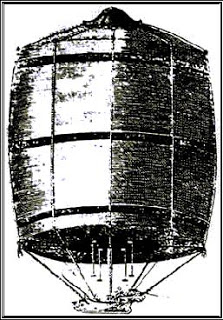Annotation:Balloon (1) (The)
X:1 T:Bolloon (sic), The T:Balloon [1], The M:C| L:1/8 R:Strathspey S:McGlashan - Reels (c. 1786) Z:AK/Fiddler's Companion K:A A<EA<c B>A B<c|e<c B>A B>A F2|A<EA<c B>AB>c|e<c B>c A/A/A A2:| A/a/g/a/ f/e/d/c/ d/e/f/e/ d/c/B/A/|B/c/d/c/ d/c/B/A/ B>G F2|A/a/g/a/ f/e/d/c/ d/e/f/g/ ac|B>ABc A/A/A A2| A/a/g/a/ f/e/d/c/ d/e/f/e/ d/c/B/A/|B/c/d/c/ d/c/B/A/ B>A F2|A<EA<c B>ABc|e<c B>c A/A/A A2||
BALLOON [1], THE. Scottish, Strathspey (whole time). A Major. Standard tuning (fiddle). AAB (McGlashan): AABB' (Campbell). The strathspey "The Balloon" in McGlashan's 1786 collection probably refers to the first documented balloon ascent on British soil, in Edinburgh, August, 1784. A correspondent to the London Journal submitted this eyewitness account:
Edinburgh, Aug. 27, 1784.
Mr. Tytler has made several improvements upon his fire balloon. The reason of its failure formerly was its being made of porous linen, through which the air made its escape. To remedy this defect, Mr. Tytler has got it covered with a varnish to retain the inflammable air after the balloon is filled.
Early this morning this bold adventurer took his first aerial flight. The balloon being filled at Comely Garden, he seated himself in the basket, and the ropes being cut he ascended very high and descended quite gradually on the road to Restalrig, about half a mile from the place where he rose, to the great satisfaction of those spectators who were present. Mr. Tytler went up without the furnace this morning; when that is added he will be able to feed the balloon with inflammable air, and continue his aerial excursions as long as he chooses.
Mr. Tytler is now in high spirits, and in his turn laughs at those infidels who ridiculed his scheme as visionary and impracticable. Mr. Tytler is the first person in Great Britain who has navigated the air.


Tytler earned the nickname "Balloon Tytler" from his 1784 ascent from Comely Gardens, Edinburgh, in a hot-air balloon—the first such in Scotland. He was educated for the church, but switched to medicine, and was occupied for much of his life in literary and chemical investigations as an apothecary. He is also justly famous as the editor and principal compiler of the original Encyclopedia Britannica. However, despite these successes, Tytler was often in poverty and his literary writings, save his essays, have been criticized; his reputation was not helped by the fact that he took on "hack work for low pay." Socially, he has been described as an outcast, and he had to flee his native Scotland several times due to (variously) financial and political trouble, forcing him to finally flee to Belfast and then America. Even his aerial adventures ended in ridicule as his attempts after his first success were less than spectacular. In one humiliating experience, his balloon only rose significantly after he descended from the attached basket, disappointing the crowd and even leading to charges of cowardice. He was soon overshadowed by the more spectacular balloon ascents of Vincenzo Lunardi, the handsome and entrepreneurial Italian 'Daredevil Aeronaut' whose success inspired ladies' fashions in skirts and hats (the "Lunardi bonnet" is mentioned in the poem "To a Louse" by Robert Burns). Tytler died in Massachusetts in 1804.

